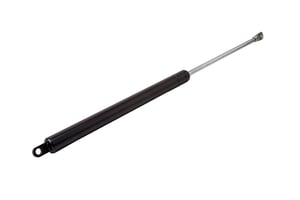 Gas springs and their close cousins are abundant in many industries and applications. From overhead bins in airplanes, and from cargo doors to armored vehicle doors, gas springs have a variety of applications.
Gas springs and their close cousins are abundant in many industries and applications. From overhead bins in airplanes, and from cargo doors to armored vehicle doors, gas springs have a variety of applications.
Their relatively simple design makes them an affordable option to create force or support moving objects. But, how do gas springs work in practice? Your motion control design will benefit if you understand these key points:
How Do Gas Springs Work?
Gas springs work in a similar manner to your basic mechanical compression spring. However, instead of using elastic deformation to store potential energy, they use gas cylinders to store energy pneumatically (fancy talk for “moved by air pressure”). These springs usually use nitrogen gas, but not always.
Compressing the gas by pushing the piston into the cylinder stores energy, which is released when the piston slides out. Just like a basic mechanical spring, gas springs don’t have any innate motion control ability.
While gas springs usually have a short stroke, meaning the spring travels over a relatively small distance, once the energy starts releasing and the spring starts expanding, it goes all out until the maximum stroke length is reached.
Depending on the application, this can produce significant force.
Notably, gas springs provide a near-constant force. (For reference, mechanical or wire springs change force when deflected.)
With the right design, heavy-duty gas springs can produce an impressive amount of force. No wonder they’re popular in applications like stamping dies, where the stamping press needs to slam down with enough force to stamp shapes out of solid steel and other tough metals.
Are Gas Struts Different Than Gas Springs?

Gas strut -- also known as compression gas spring -- is a term often swapped with gas springs too. There are subtle differences that are important to understand when you’re designing with these devices.
Gas struts have similar design characteristics to standard gas springs, but they also incorporate compressed gas and a circuit for dampening the force as needed. The circuit lets you control how fast the spring moves either going out, coming back in, or both. Gas struts can pull or push depending on how you configure them.
A quick look around and you’ll find a compression gas spring hinge on many devices in your day-to-day life, such as the pistons on the hatchbacks of cars or gas struts for heavy-duty lid applications. As you push the door down, you’ll feel some resistance. The latch on the door holds the pressurized springs in place while it’s closed, but as soon as you unlatch the door and start to pull it out you, notice the pressure start to build and force the door back open.
The gas strut hinges on these devices usually have circuits that keep them from pushing so fast and hard that they damage the door or injure the user.
How Long Do Gas Springs Last?
One of the challenges with gas springs is predicting how long they’ll last -- because you can’t. There are design limitations with gas springs that make them prone to wear when subjected to frequent use. They tend to lose a little force and general performance year after year, although some high-end options offer warranties as high as 15 years. A longer useful life, of course, comes with a higher price tag.
If they are used in extreme conditions, such as in a French door oven or a cryogenic freezer, gas springs can wear out quickly and become a hazard. In extreme heat or cold, designers often opt for longer-lasting counterbalance systems. They stand up to the extra wear and tear of heat and cold because they don’t rely on gas pressure.
In any condition, the most common reason for gas spring failure is the loss of the nitrogen gas and lubricating oil inside. You can blame the rubber seal, as over time it sustains
- Cracks
- Corrosion
- Wear
- Damage
This leads to the escape of gas and oil, eventually resulting in the failure of the spring. Loss of pressure in gas spring, whether it’s totally failed yet or not, may cause a serious accident if you don’t replace it in time. Not sold on gas springs? Check out our other type of industrial hinges below:
Other Concerns With Gas Springs
The biggest concern with gas springs is the risk of explosion. A gas spring should never have a home in extreme-temperature products, nor in medical or food applications where leaking materials could cause contamination. The internal pressure is simply high with gas springs, particularly when you apply heat. In these products, custom hinge fabrication experts often use mechanical spring hinge designs instead.
The last major consideration with gas springs is adjustability. They cannot be adjusted mid-life, so you need to be sure that you have the design you want over the long term when you go with gas springs. Designers will often pick a gas spring that initially provides excessive force so that as it loses force overtime, it’ll still work. Think of a brand-new hatchback and how hard it can be to close when you first buy it. Over time, closing it becomes easier; sometimes the door even sags near the end of the spring’s useful life.
Mechanical Springs Vs. Gas Springs
Gas springs provide a cheap boost to any motion control or counterbalance design. The ability of gas struts to include dampening features can introduce a slow-close feature to prevent slamming of a door, lid, or cover.
In many other projects, though, a mechanical spring is:
- Safer
- More cost-effective in the long-term
- Higher-quality
- Adjustable
If you have questions about whether to use gas springs vs. mechanical springs, simply ask an engineer below. We’ve worked with both!
(Editor's Note: This blog post was originally published in February 2020, and was updated in August 2021)
.png?width=12000&height=2033&name=WeberKnappLogo_white%20(1).png)



